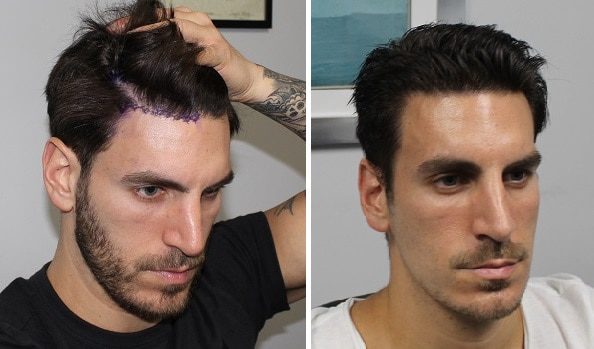The hairline region is very important in hair transplant surgery. This is for several reasons: 1) it is one of the most visible regions of the scalp, and the one that is first “seen” when someone looks at a patient’s face; 2) it is one of the first regions where men experiencing genetic patterned hair loss see the thinning; 3) because of reasons 1 and 2, it is one of the most common regions we rebuild with hair transplant surgery. Because of this, patients almost universally ask during a consultation: “So, what should my new transplanted hairline look like?” Should it be flatter, more defined, and more symmetric? Should it be more irregular, staggered, and feathered? The truth is that there is no “one size fits all” when it comes to transplanted hairlines. What looks good for one patient may not look good for another; what makes sense for a young patient with progressing and uncertain loss may not make sense for an older patient with more “stable” and limited hair loss. In other words, hairlines must be carefully considered and customized for each patient.
In order to help potential patients understand the importance of hairline customization and choosing the right plan for the right individual, we made a series of videos discussing this and showcasing two different hairlines for two very different patients. By presenting these two different patients and explaining why we designed the specific hairlines for each one, we believe researching patients may better understand the importance of customizing transplanted hairlines and possibly know what to expect when they ask their own doctor: “what should my new transplanted hairline look like?”
The first patient is a young male in his mid-to-late 20’s. The patient was experiencing hair loss in the frontal region, and requested a rebuild of this area. Upon examination we discovered that he was, in fact, a good candidate for restoration in this area, but he was also likely to have more hair loss up the road. We also noted that he had finer, lighter hair, and a more narrow shape to his forehead. After taking all of these factors into account, we decided to design a slightly more conservative, soft, broken-up, irregular, and feathered hairline for his case. To learn more about why we took this approach for this patient and to see his results, please view the following video:
The second patient is a gentleman in his late 40’s to early 50’s who presented with limited loss in the frontal band region — and some slight isolated loss in the crown. Based upon his age, level of hair loss, hair-type, and forehead shape, we decided to design a flatter, more defined, less irregular hairline for his case. Though some may think this might stand out as “less natural” compared to a soft, more “broken-up” hairline, we demonstrate in the following video how this approach was actually best for his case:
As you can see, these patients were about as opposite as you can get. One was younger with finer hair and a more aggressive type of loss, while the other was older with darker, coarser hair and limited hair loss in general. Doing the exact same hairline on these two patients would not make sense. The way one patient’s hairline “should look” is not the way the other patient’s hairline “should look.” This is because transplanted hairlines must be customized. Patients must visit clinics who are able to showcase a wide variety of hairlines; not a “stock” hairline done time and time again on each patient. The hair transplant doctor must take your entire “picture” into account, digest the information, and create a plan that fits you and you alone. If you do this, your hairline will look like one thing and one thing alone: a natural hairline which fits you. When considering clinics, make sure to ask the doctor what they plan to do for your hairline specifically, why they recommend this approach, and to see examples of other, similar hairlines. Otherwise, you may end up in a situation where you are asking a second doctor what your hairline should have looked like, and whether or not they can make it look like this with a second procedure.
________
Dr. Blake Bloxham
Feller & Bloxham Medical, PC






